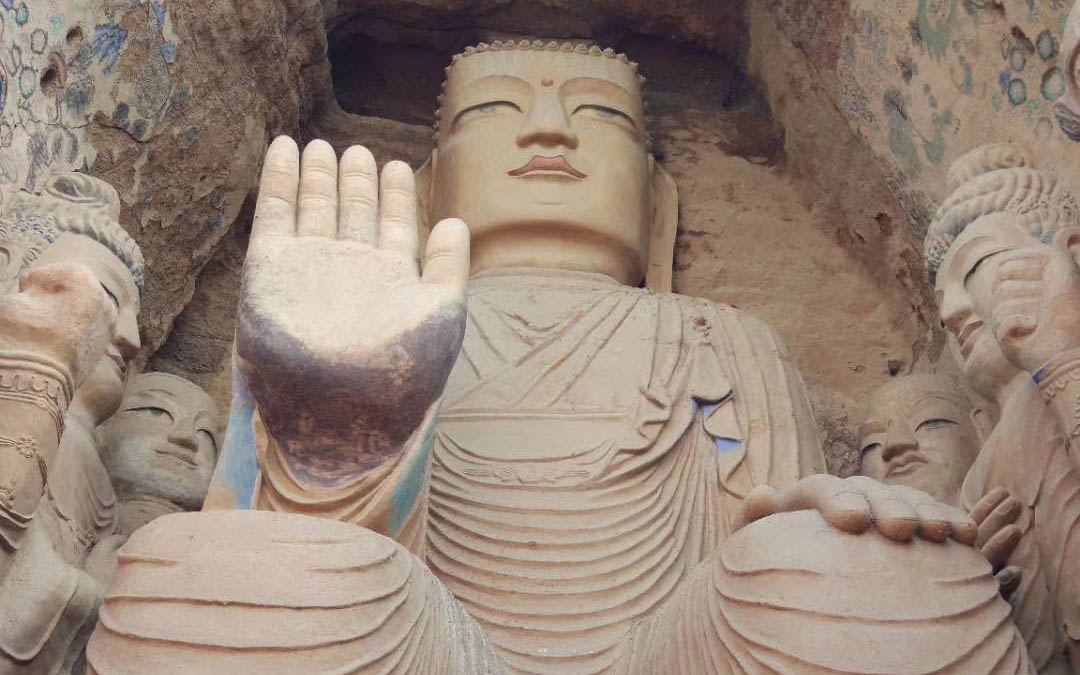As national important cultural relics protection unit, the Heaven Ladder Mountain Grottoes is located in the Dengshang village, Zhonglu township, about forty kilometers to the south of Wuwei City. The Grottoes got its name just because they were carved on cliffs which made it look like a ladder to the heaven. The snow on the peak of the Heaven Ladder Mountain remains all year round and the mountain enjoys the irrigation of springs. "Snow on the Heaven Ladder Mountain" makes one of the eight scenes of Wuwei Ci ty. The Heaven Ladder Mountain Grottoes, one of the earliest carved, was done about 1500 years ago. It is even earlier than Yuangang Grottoes and Longmen Grottoes. After the Heaven Ladder Grottoes was carved, many eminent monks came here from the west among them the most famous one was Hao Wuxie. He was from the middle part of India. When he was young, he concentrated in Hinayana and later he learned Mahayana with a senior Chan master. From then on he devoted himself to Mahayana. He traveled from middle India to the now Keshmire, Youzi, Shanshan to Dunhuang. Several years later he came to Wuwei and expounded the text of Buddhism at the Heaven Ladder Grottoes. Mengxun thought much of him and took him as honorable guest. Hao Wuxie was quite active in learning Chinese and he took the lead in the translation work of many Buddhism texts all of which were the texts of Mahayana advocating the belief that every living thing is blessed with the spirit of Buddha. His work played an important role in the spread of Mahayana, and at the same time made the Heaven Ladder Mountain Grottoes even more famous.
Later the Heaven Ladder Mountain Grottoes was extended several times in the North Wei, the Sui Dynasty, the ang Dynasty and the West Xia. Till Ming and Qing Dynasty, the Grottoes was made of temple of Tibet Buddhism. Because of the spongy topsoil, the grotto suffered destruction to different degrees in every serious earthquake. Only in the serious earthquake in 1927 in Wuwei, more than ten caves were completely destroyed. After 1949, only eight caves had statuesand wall paintings. In 1959, the construction of Huangyang Reservoir made some of the statues and wall paintings move to the Provincial Museum of Gansu. The Tibet buddhism texts were reserved by Dunhuang Cultural Relics Research Institute. During the Cultural Revolution, the remaining statues and painting were destroyed again.
Nowadays only three floors of the Grottoes with seventeen caves are still in existence. Among these caves is one big cave as huge as thirty meters high, nineteen meters wide and six meters deep. A statue of Sakyamuni, as high as fifteen meters and as wide as ten meters, is on display. The statue is facing water with its left hand on the knee, the right arm and the center of the palm facing forward and his eyesight conveying wisdom. To the sides of Sakyamuni stood "two disciples", "two Bodhisattvas "and "two Heavenly Kings"who are vivid and lively enough with different facial expressions. The "two Disciples" here refers to Jia Ye and A Nan. The two "Bodhisattvas" are Wen Shu and Pu Xian. And the "two Heavenly Kings" are Guang Mu and Duo Wen. Here are huge murals on the inner south and north wall of the cave. On the south wall, there is a dragon on the top a white elephant with shining Buddhism texts and a spotted deer in the middle and tigers, trees and flowers at the bottom. On the north wall, a dragon and two tigers are painted on the top, white horses with shining Buddhism texts, black tigers and budhi trees in the middle and peonies at the bottom. The whole murals are fresh in color, vivid in lines and could vividly convey Buddhism stories.
The Heaven Ladder Mountain Grottoes is the representative of the earliest grottoes in our country, and it enjoys an important role in the history of Buddhism. Later when Yungang Grottoes was carved in Datong in the North Wei, all the craftsmen came from here. Even the person in charge was a monk named Tanye from Wuwei. (By Yi Ming)







